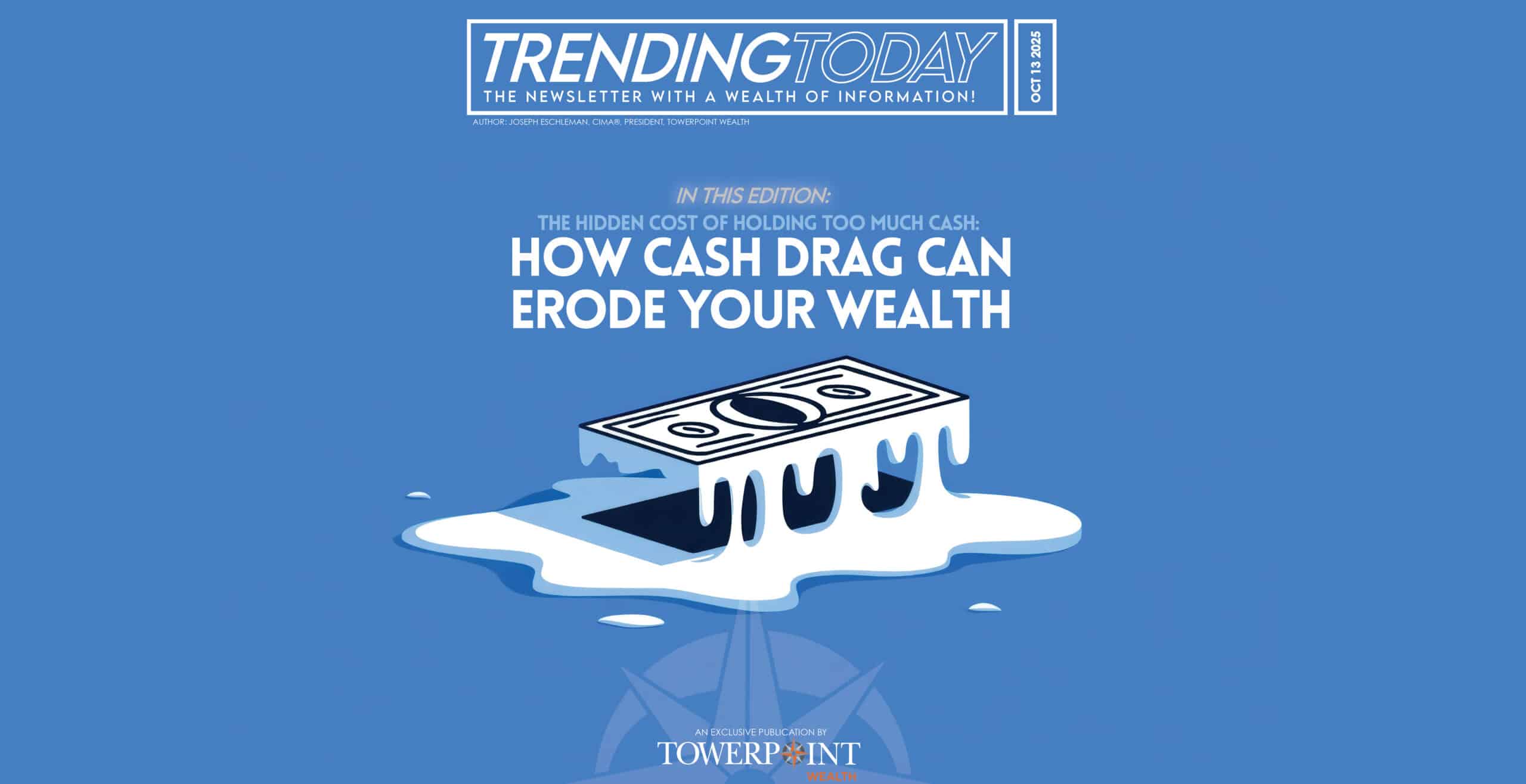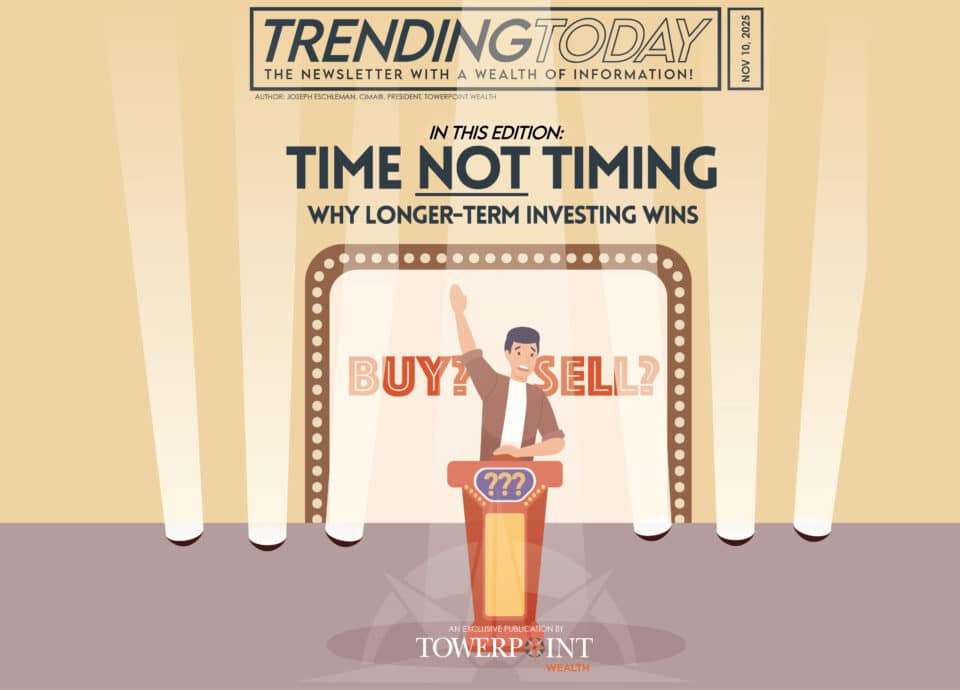It can feel comforting to watch a large cash balance grow in your checking or savings account. Liquidity feels safe, especially when markets are unpredictable.
But there’s a quieter, more subtle risk many investors overlook: cash drag.

When too much of your wealth sits idle, it loses purchasing power to inflation and misses the longer-term growth that disciplined investing provides. What seems like a cautionary practice can actually become a financial opportunity cost — a silent erosion of your future lifestyle and goals.
At Towerpoint Wealth, we understand the desire for and importance of security. Cash does have its place in a well-built wealth management plan: emergency funds, shorter-term spending needs, strategic reserves. However, holding far more than you need can weigh down performance and delay progress toward financial independence.
In this article, we’ll discuss the hidden costs of holding cash, why excess liquidity often works against you, and how a thoughtful cash flow management strategy can strike the right balance between peace of mind and portfolio growth.
Key Takeaways
- Holding excess cash may feel safe, but it creates cash drag — your money may grow far more slowly than a diversified portfolio.
- Inflation steadily erodes the purchasing power of idle cash, especially when interest rates on savings and money market accounts lag behind rising prices.
- A solid cash flow management strategy balances an adequate emergency fund with longer-term investments for growth.
- Putting surplus cash to work through diversified portfolios, shorter-term higher-yield options, or tax-efficient investing strategies helps reduce the cash drag opportunity cost.
- Regular reviews with a fiduciary financial advisor help to ensure your cash levels stay aligned with goals, market conditions, and interest-rate changes.
Why People Hold Excess Cash
For many investors, holding cash feels like the safest move — especially when headlines warn of market volatility or economic uncertainty. A big balance in a checking or savings account can seem like a financial comfort blanket.
But this instinct, often called cash hoarding, is more emotional than strategic.
Psychology plays a powerful role. Fear of market swings or memories of past downturns can keep investors parked on the sidelines, even when the data shows that longer-term investing is the most reliable way to build wealth. Recent economic surprises — rising interest rates, trade tensions, political uncertainty, and unpredictable economic policy changes — have only reinforced the temptation to stay liquid “just in case.”
Excess cash holdings can also stem from life events. After selling a business, receiving an inheritance, or experiencing another liquidity event, it’s common to let large sums sit idle while deciding what to do next. And while shorter-term caution can make sense, longer-term inaction can quietly erode purchasing power as inflation outpaces savings rates.
The takeaway: cash plays an important role in an emergency fund or for planned near-term spending, but too much of it creates financial opportunity cost — a drag on your ability to grow and protect wealth over time.
Understanding Cash Drag
“Cash drag” is the silent cost of letting too much money sit idle. In plain terms, it’s the gap between what your cash earns in a low-interest savings account and what it could earn if it were invested in a diversified portfolio. When inflation rises faster than your savings account yields, that gap compounds year after year.
Let’s look at a simple example.
Suppose you keep $500,000 in cash savings earning 1.5% annually over 10 years. Even with modest inflation of 2%, the real value of that cash falls behind every year.
In contrast, a diversified portfolio historically averaging about 6-7% annually could grow that same $500,000 to roughly $900,000-$1 million over the same period — more than double the cash balance. That difference is the opportunity cost of holding cash.
And the drag of holding too much cash isn’t just theoretical. Cash-heavy portfolios consistently lag those that stay more fully invested. And because markets can compound gains, even a few years of sitting inactive can permanently reduce longer-term wealth.
While it’s wise to keep enough cash for an emergency fund or planned expenses, excess liquidity creates financial opportunity costs that can quietly undermine retirement planning, legacy goals, and overall financial independence.
At Towerpoint Wealth, we emphasize disciplined cash flow management strategies that keep your money working without compromising flexibility. Understanding cash drag is the first step toward striking the right balance of maintaining security while avoiding the hidden costs of too much cash.
The Opportunity Cost of Holding Cash
Holding too much cash feels safe, but it quietly erodes wealth.
Financial opportunity cost is the return you forfeit by parking money in low-yielding accounts instead of investing it for growth. When cash earns less than inflation, your purchasing power declines year after year — even if the balance looks the same.

From 2005 to 2025, U.S. inflation has averaged about 2.6% annually, while the typical savings account has often paid less than 1%. That gap means a dollar sitting in cash buys less every year.
Compounding makes the effect even sharper: $100,000 left in an account yielding 1% for a decade loses nearly 20% of its real value if inflation runs at 3%.
Meanwhile, a well-diversified portfolio historically has a real return closer to 6-7% per year. The difference between those growth rates is the opportunity cost of holding cash — wealth you could have built but didn’t.
This doesn’t mean you should invest every dollar you have. An emergency fund and shorter-term spending needs likely belong in cash. But beyond that, excess liquidity drags on longer-term results. The longer money sits idle, the harder it is to catch up, because lost compounding can never be recovered.
At Towerpoint Wealth, we help clients find the right balance between stability and growth, using a disciplined cash flow management strategy that keeps essential reserves intact while ensuring surplus dollars work toward your retirement, legacy, and lifestyle goals. Understanding opportunity cost is key to making every dollar pull its weight.
Cash Flow Management Strategy: How Much Cash Is “Enough”?
Keeping the right amount of cash on hand is important — but holding too much can weigh down your longer-term returns. A disciplined cash flow management strategy helps strike a balance between security and growth.
Start with an Emergency Fund
Many advisors generally recommend maintaining 3–6 months of living expenses in highly liquid accounts. Business owners, retirees, or those with irregular income may want a larger cushion — closer to 9–12 months — since their cash needs can be less predictable.
This reserve should cover essential expenses like housing, insurance, and basic living costs, providing peace of mind when unexpected events arise.
Separate Shorter-Term Needs from Longer-Term Goals
Cash you’ll need in the next year — for big purchases, taxes, or a planned vacation — should remain readily accessible. Beyond that, excess cash may be better directed toward diversified investments, retirement accounts, or other longer-term vehicles where it can potentially grow and outpace inflation.
The key is to avoid letting “just in case” cash quietly turn into unproductive cash hoarding.
The Value of Professional Guidance
Every household’s situation is different. A fiduciary financial advisor can help you calculate the right reserve, forecast upcoming expenses, and design a personalized cash flow management strategy. This helps to ensure that surplus funds are intentionally deployed toward your unique financial goals while still keeping an appropriate safety net in place.
Smart Ways to Put Excess Cash to Work
Once your emergency fund is set and shorter-term needs are covered, the next step is to give any surplus dollars a job to do. A thoughtful approach helps reduce cash drag while still aligning with your risk tolerance and goals.
Build a Diversified Portfolio
For money you won’t need for several years, a diversified mix of equities, bonds, and alternatives can help you capture longer-term growth while managing risk. A balanced portfolio spreads exposure across asset classes, improving the odds of steady returns.
Use Shorter-Term, Higher-Yield Options
If you anticipate needing the funds within the next year or two, consider shorter-duration investments such as Treasury bills (T-bills), high-quality shorter-term bond ETFs, or money market funds.
These options often pay more than a standard savings account while keeping liquidity high.
Ease In with Dollar-Cost Averaging
If market volatility makes you hesitant to invest a lump sum, a dollar-cost averaging strategy — investing smaller amounts at regular intervals — can help smooth out market swings and reduce the emotional stress of timing the market.
Explore Tax-Efficient Strategies
For longer horizons, consider Roth IRA conversions or tax-managed funds to turn idle cash into tax-advantaged growth. Contributing to a health savings account (HSA) or funding a 529 college plan can also help minimize taxes while advancing future goals.
Planning in Different Economic Environments
Cash decisions don’t exist in a vacuum — they’re often shaped by the broader economy. Interest-rate cycles, inflation trends, and market volatility all influence how much cash investors may want to keep on hand and how they choose to deploy excess dollars.
When interest rates rise, high-yield savings accounts, CDs, and shorter-term Treasury bills can provide more competitive returns without sacrificing liquidity. But when rates fall, the opportunity cost of holding cash increases, making longer-term investments more attractive.
Periods of elevated inflation require an even closer look. Sitting on too much cash during inflation erodes purchasing power, as rising prices outpace the modest returns on savings.
Conversely, during times of market stress or recession fears, it can feel tempting to retreat entirely to cash. While a healthy emergency fund is crucial, staying invested in a diversified portfolio remains the best way to preserve — and grow — wealth over time.
Regular portfolio rebalancing and periodic reviews with a fiduciary financial advisor help keep your cash allocation aligned with your goals, regardless of the economic backdrop. A disciplined process ensures that shorter-term safety doesn’t compromise longer-term growth.
Final Thoughts
At Towerpoint, we know cash provides comfort — but too much of it can quietly erode your wealth. Our fiduciary planning process helps clients strike the right balance between liquidity and longer-term growth.
We begin by identifying how much cash you truly need for emergencies and near-term spending, then set clear thresholds to avoid unnecessary cash drag. From there, we develop a tailored plan to deploy excess funds into diversified investments or tax-efficient strategies that align with your goals.
If you’re wondering whether you’re holding more cash than you need, we invite you to schedule a complimentary 20-minute “Ask Anything” call. Together, we can review your cash position and design a strategy that keeps your money working as hard as you do.







